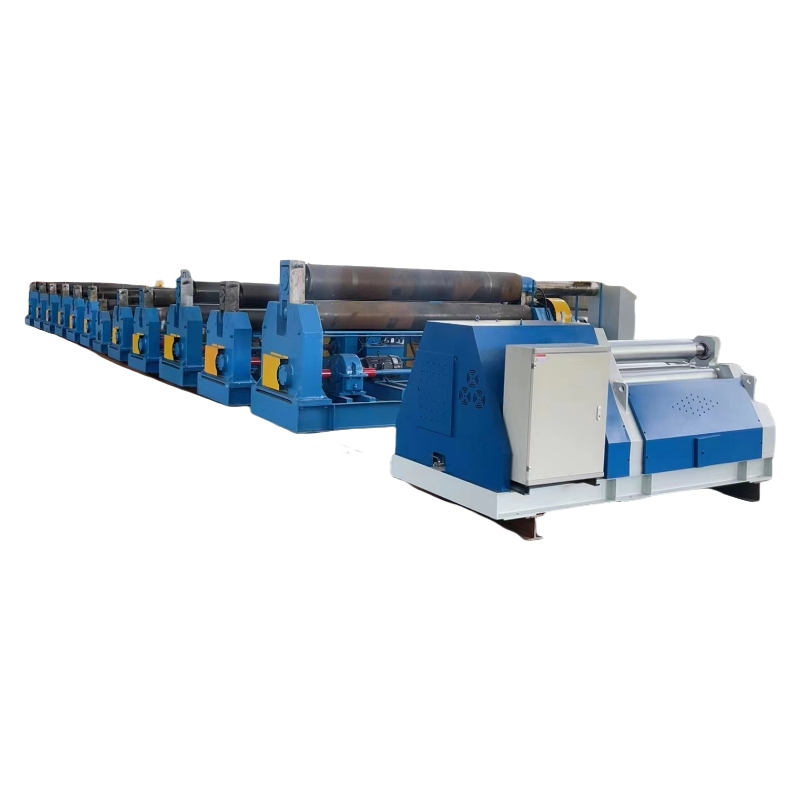Understanding Plate Rolling Machines: A Comprehensive Overview
Plate rolling machines are essential tools in the metalworking industry, enabling the bending and shaping of metal sheets into various forms. These machines are widely used in sectors such as shipbuilding, construction, and manufacturing, where precision and efficiency are crucial. At AIFOYIN, we specialize in high-quality plate rolling machines designed to meet diverse industrial needs. In this blog, we will provide a comprehensive overview of plate rolling machines, their types, features, and applications.

What is a Plate Rolling Machine?
A plate rolling machine is a piece of equipment that rolls metal sheets into cylindrical or conical shapes. The process involves applying pressure to the edges of the metal sheet, causing it to bend and take on the desired curvature. This capability is vital for producing components like pipes, tanks, and other curved structures.
Key Components of Plate Rolling Machines
1. Rollers: The primary components that apply pressure to the metal sheets. They can be configured in various ways depending on the type of machine.
2. Drive System: Powers the rollers and controls their movement.
3. Control Panel: Allows operators to set parameters and monitor the rolling process.
4. Frame: Provides structural support for the machine.
Types of Plate Rolling Machines
1. Three-Roller Plate Rolling Machines
Three-roller machines are among the most common types used in metal fabrication.
Features:
- Configuration: Consists of three rollers arranged in a triangular shape.
- Applications: Suitable for rolling thicker plates and producing tight radii.
- Advantages: Offers better control over curvature and is efficient for various thicknesses.
Ideal Use Cases:
These machines are ideal for manufacturing cylindrical shapes such as pipes, tanks, and pressure vessels.
2. Four-Roller Plate Rolling Machines
Four-roller machines feature four rollers that provide enhanced control over the bending process.
Features:
- Configuration: Two upper rollers are adjustable while two lower rollers remain fixed.
- Applications: Capable of handling thicker materials and producing more precise shapes.
- Advantages: Reduces material wastage due to better control over initial bending.
Ideal Use Cases:
Perfect for industries requiring high precision and efficiency, such as shipbuilding and heavy equipment manufacturing.
3. Hydraulic Plate Rolling Machines
Hydraulic plate rolling machines utilize hydraulic power to apply force to the rollers.
Features:
- Design: Uses hydraulic cylinders to adjust roller positions.
- Applications: Ideal for rolling thick plates and large diameters.
- Advantages: Provides significant power and flexibility in operation.
Ideal Use Cases:
Commonly used in industries that require heavy-duty metal forming, such as construction and oil & gas.
4. Mechanical Plate Rolling Machines
Mechanical plate rolling machines rely on mechanical gears and levers to operate.
Features:
- Design: Uses a system of gears to control roller movement.
- Applications: Suitable for lighter materials and thinner plates.
- Advantages: Generally more affordable than hydraulic models.
Ideal Use Cases:
Best suited for smaller workshops or operations that do not require heavy-duty capabilities.
5. Vertical Plate Rolling Machines
Vertical plate rolling machines are designed to roll plates in a vertical orientation.
Features:
- Design: Plates are fed vertically into the machine.
- Applications: Useful for rolling larger sheets or when space is limited.
- Advantages: Allows for easier handling of large plates without requiring additional lifting equipment.
Ideal Use Cases:
Ideal for applications where space constraints exist or when working with particularly large sheets of material.
Key Features of AIFOYIN Plate Rolling Machines
At AIFOYIN, our plate rolling machines come equipped with various features designed to enhance performance:
1. High Precision End Pre-Bending: Ensures accurate shaping at the edges of the material.
2. NC Control Systems: Facilitates high production efficiency with user-friendly interfaces.
3. Rich Bending Shapes: Capable of producing various profiles to meet diverse project requirements.
4. Safety Features: Designed with safety in mind to protect operators during use.
5. Convenient Mobility: Many models feature a simple base structure for easy movement around the workshop.
Applications of Plate Rolling Machines
Plate rolling machines find extensive applications across various industries:
1. Shipbuilding: Used to create hulls, tanks, and other curved components.
2. Construction: Essential for producing structural elements like beams and arches.
3. Manufacturing: Employed in creating parts for machinery and equipment.
4. Automotive Industry: Used for components such as exhaust systems and chassis parts.
Conclusion
Plate rolling machines are indispensable tools in modern metal fabrication, enabling manufacturers to create complex shapes with precision and efficiency. Understanding the different types of plate rolling machines available can help you make an informed decision based on your specific needs.
At AIFOYIN, we offer a wide range of high-quality plate rolling machines tailored to meet various industrial requirements. If you have any questions about our products or need assistance selecting the right plate rolling machine for your operations, feel free to reach out! Together, we can ensure that your metalworking projects are completed efficiently and effectively.
- Art
- Causes
- Crafts
- Dance
- Drinks
- Film
- Fitness
- Food
- Jogos
- Gardening
- Health
- Início
- Literature
- Music
- Networking
- Outro
- Party
- Religion
- Shopping
- Sports
- Theater
- Wellness


